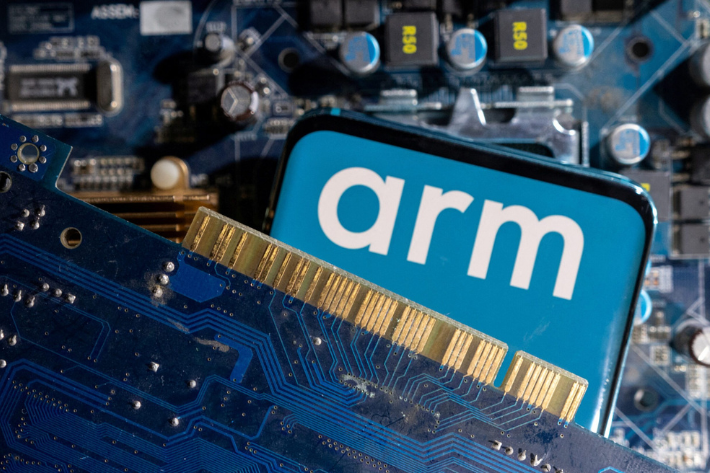SoftBank Group Corp is in talks to buy the 25% stake in chip designer Arm Ltd it does not directly own from Vision Fund 1 (VF1), sources say.
The move could potentially deliver a win for investors who have waited years for strong returns. VF1 is a $100-billion investment fund SoftBank raised in 2017.
The discussions come as SoftBank, which currently owns 75% of Arm, is preparing to list the chip designer on Nasdaq next month at a valuation of $60 billion to $70 billion.
ALSO SEE: SoftBank Set to Finally See Green as Tech Valuations Jump
Deal could yield windfall for VF1 after losses
If the negotiations lead to a deal, the Japanese tech investor would be delivering a major, immediate windfall to VF1 investors, including Saudi Arabia’s Public Investment Fund and Abu Dhabi’s Mubadala.
These investors have nursed losses after many of SoftBank’s bets on startups such as workspace provider WeWork and ride-sharing firm Didi Global soured.
The alternative – letting VF1 sell its Arm shares in the stock market over time following the initial public offering (IPO) – would typically take at least one to two years given the size of the stake.
It would also be more risky for the fund’s investors since it is possible that Arm’s shares could drop following the IPO.
VF1 returned to profitability in the latest quarter thanks to investors’ excitement around artificial intelligence boosting the value of some of the startups in which it invested.
Yet its previous losses prevented SoftBank from securing outside investors for Vision Fund 2 (VF2), whose $56 billion in capital came from the Japanese firm and its management, including chief executive Masayoshi Son.
A big windfall for VF1 investors could boost SoftBank’s chances of tapping them for capital again in the future, though SoftBank currently has no plans to do so, according to the sources.
Son, who has hired investment bank Raine Group to advise SoftBank on the negotiations, has recused himself from VF1’s deliberations on the matter so that the fund makes a decision independently in the interest of its investors, the sources said.
VF1 committee, SoftBank advisers in talks
VF1’s investment committee and SoftBank’s investment advisory board, attended by fund investor representatives, are handling the negotiations, one of the sources added.
The exact valuation for Arm that the two sides are discussing for their transaction could not be learned, and the sources cautioned that it is possible that no agreement will be reached.
If a deal is inked, SoftBank would be selling fewer Arm shares in the IPO and would be likely retaining a stake of between 85% and 90%, according to the sources, who requested anonymity because the negotiations are confidential.
SoftBank, VF1 and Arm declined to comment. Raine did not immediately respond to requests for comment.
Advances in AI spur excitement
Arm’s IPO would be a boon not just for VF1 but also for SoftBank, which reported its third consecutive quarterly loss last week. It was hit by declines in the valuations of major holdings such as Chinese e-commerce firm Alibaba Group, German telecommunications company Deutsche Telekom and US wireless carrier T-Mobile US.
SoftBank, which took Arm private for $32 billion in 2016, sold a 25% stake in the company to VF1 for $8 billion in 2017. SoftBank has also been in talks with several technology companies about bringing them onboard as cornerstone investors in Arm ahead of its IPO, including Amazon.com.
SoftBank last week said VF1 delivered a gain of $12.4 billion on $89.6 billion of investments, while VF2 carried a $18.6 billion loss on $51.8 billion of investments.
The investment giant has been in “defence mode” since May 2022 after technology valuations crashed amid a rise in interest rates and economic uncertainty. But in June, Son said he was planning to shift to “offence” mode amid excitement over advances in artificial intelligence.
SoftBank began preparations for an IPO of Arm after a deal to sell the company to Nvidia Corp for $40 billion collapsed last year over objections from US and European antitrust regulators.
Arm has been considering an offering up to $10 billion for its listing. Its plans to go public come as the US IPO market shows signs of a recovery after an arid spell that lasted a year and a half, as major companies including grocery delivery service Instacart and marketing automation firm Klaviyo get ready to list in New York.
Earlier this year, Arm rebuffed a campaign from the British government to list its shares in London and said it would pursue a flotation on a US exchange.
Arm’s business has fared better than the broader chip industry because it licenses designs rather than paying to make processing systems itself.
Its technology has become ubiquitous in smart phones and data centres, delivering lucrative royalty payments. Yet demand for smart phones has weakened lately, weighing on Arm’s earnings.
In a show of Arm’s significance for its investment portfolio, SoftBank in April asked Arm chief executive Rene Haas to join its board of directors.
- Reuters with additional editing by Jim Pollard
ALSO SEE:
Intel Looking to Become Anchor Investor in SoftBank’s Arm IPO
AI Chip Gold Rush Pumps Up SoftBank Shares Ahead of Arm IPO
SoftBank Shares Soar as Arm Rolls Out New Smartphone Chip Tech
S&P Cuts SoftBank Rating Deeper Into Junk Over Alibaba Sale
SoftBank to List Arm in New York, Despite British Appeals
SoftBank’s Arm Cannot Sell Cutting-Edge Chip Designs to China
























